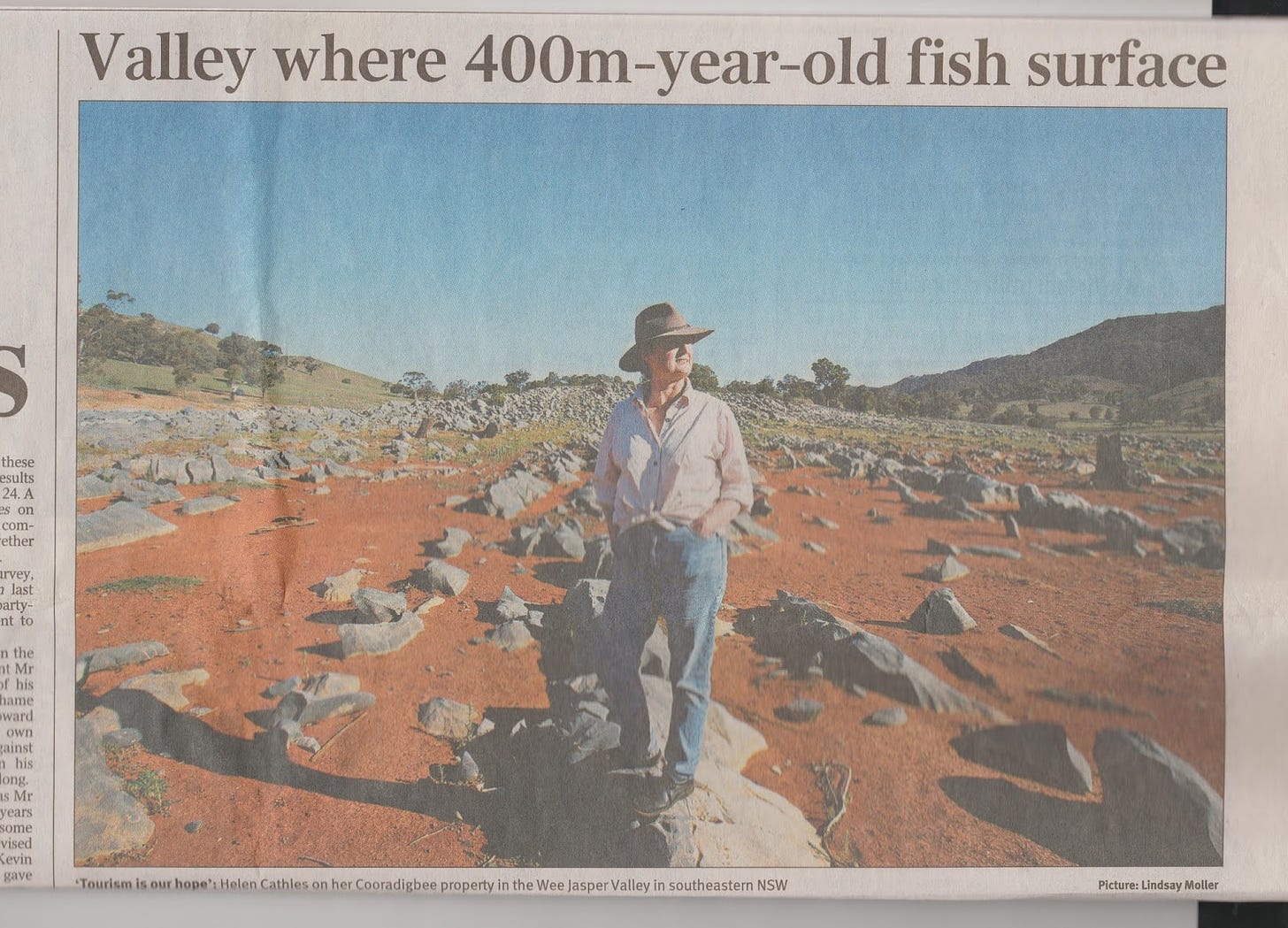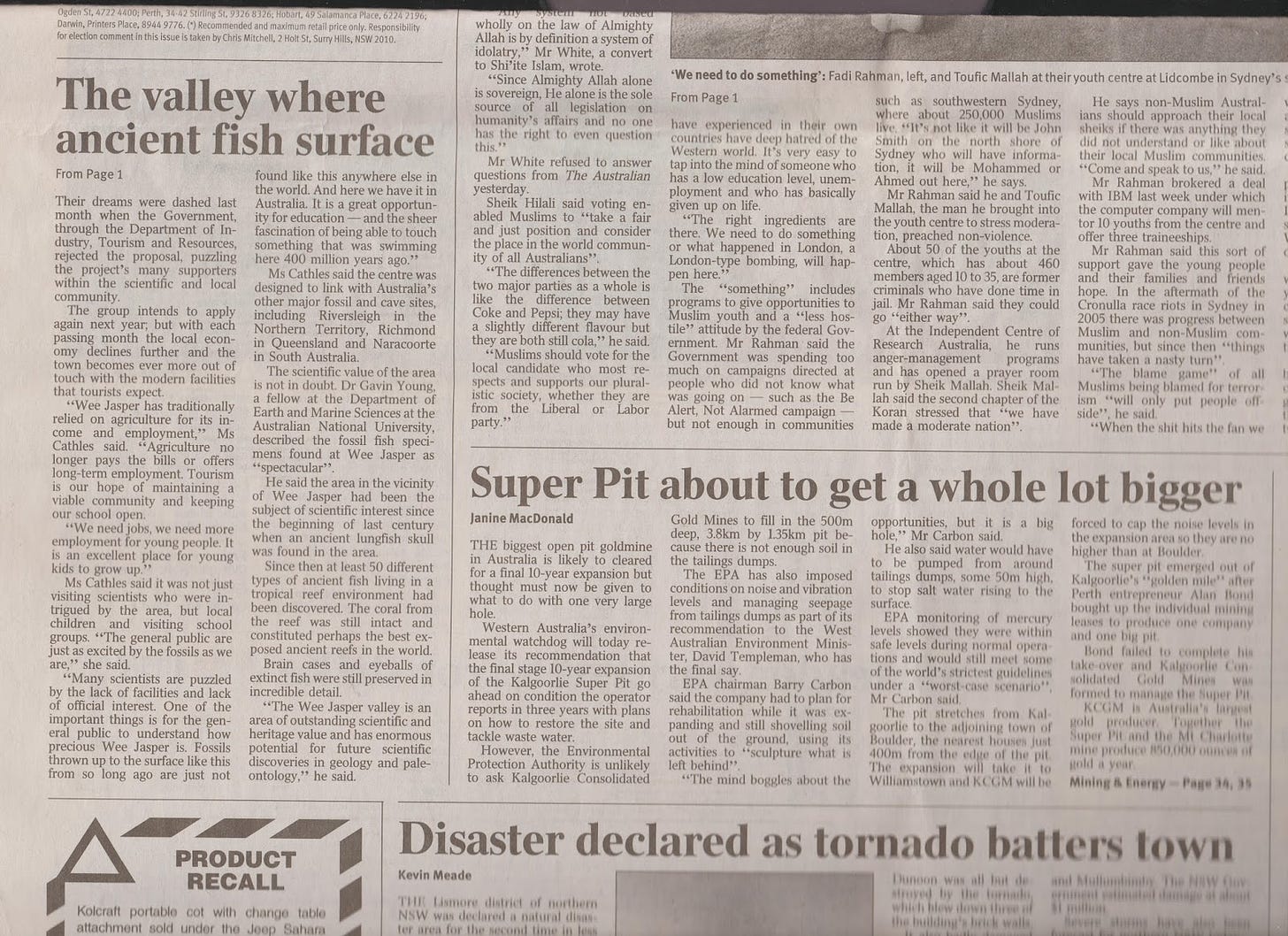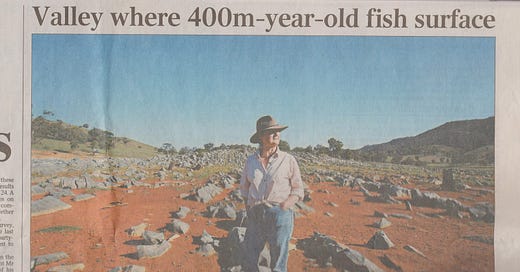Valley where 400 million-year-old fish surface, The Australian, 29 October, 2007. Page One.



Valley where 400 million-year-old fish surface: [2 All-round First Edition]
Stapleton, John. The Australian [Canberra, A.C.T] 29 Oct 2007: 3.
Abstract
A number of locals have formed a tourism group to campaign for a world-class centre for local and international tourists and the scientific community to protect the site but still give them an exciting experience. While they're looking for another name, at the moment it's called The Wee Jasper Ancient Seascape Interpretive Centre.
Money is available from the federal Government for the development of tourism in drought-affected areas deemed to be in "exceptional circumstances". But despite a voluminous and well- documented application, the Wee Jasper group has so far been unsuccessful.
"Many scientists are puzzled by the lack of facilities and lack of official interest. One of the important things is for the general public to understand how precious Wee Jasper is. Fossils thrown up to the surface like this from so long ago are just not found like this anywhere else in the world. And here we have it in Australia. It is a great opportunity for education -- and the sheer fascination of being able to touch something that was swimming here 400 million years ago."
Full Text
EVERY metre represents 5000 years of evolution. In just over a kilometre, it's possible to walk across six million years of history.
Astonishingly, it is possible to reach down and pick up a piece of armour plating from a fish that swam here 400 million years ago.
Wee Jasper, a tiny picturesque village at the western foot of the Brindabella Ranges tucked in close to the Snowy Mountains in the southern tablelands of NSW, owes its nature to cataclysmic events from the early days of the continent.
It is best known to bushwalkers and tourists for the charm of its steep valleys, wooden bridges and old farm-houses -- and for an elaborate network of partially mapped limestone caves.
But what makes Wee Jasper unique is the valley floors scarred by corrugated lines of stratified rock -- formations that are parts of an ancient 1200m-deep seabed laid down over millions of years and thrust to the surface in more recent geological periods.
Despite the picturesque landscape and scientific uniqueness of the valleys around Wee Jasper, its present circumstances are far from fitting for one of Australia's unique spots.
Only 65 people live in the Wee Jasper Valley itself and farming in the area is suffering the same dry spell as much of the country.
There is an old-fashioned kiosk, at Careys Cave just outside the village, to cater for the thousands of tourists that make their way there every year. Scientists from China, Canada and France have visited in recent years; but there are almost no facilities to help them.
A number of locals have formed a tourism group to campaign for a world-class centre for local and international tourists and the scientific community to protect the site but still give them an exciting experience. While they're looking for another name, at the moment it's called The Wee Jasper Ancient Seascape Interpretive Centre.
Money is available from the federal Government for the development of tourism in drought-affected areas deemed to be in "exceptional circumstances". But despite a voluminous and well- documented application, the Wee Jasper group has so far been unsuccessful.
Local farmer Helen Cathles, with friends and other local families, put in hundreds of hours of work on the application and were very optimistic of getting a $500,000 grant for the project. Their dreams were dashed last month when the Government, through the Department of Industry, Tourism and Resources, rejected the proposal.
The group intends to apply again next year; but with each passing month the local economy declines further and the town becomes ever more out of touch with the modern facilities that tourists expect.
"Tourism is our hope of maintaining a viable community and keeping our school open. We need jobs," Ms Cathles said.
She said it was not just visiting scientists who were intrigued by the area, but local children and visiting school groups.
"The general public are just as excited by the fossils as we are.
"Many scientists are puzzled by the lack of facilities and lack of official interest. One of the important things is for the general public to understand how precious Wee Jasper is. Fossils thrown up to the surface like this from so long ago are just not found like this anywhere else in the world. And here we have it in Australia. It is a great opportunity for education -- and the sheer fascination of being able to touch something that was swimming here 400 million years ago."
Gavin Young, a fellow at the Department of Earth and Marine Sciences at the Australian National University, described the fossil fish specimens found at Wee Jasper as "spectacular".
He said the area in the vicinity of Wee Jasper had been the subject of scientific interest since the beginning of last century.
Tourism Minister Fran Bailey refused to comment.
ORIGINAL COPY
John Stapleton
EVERY metre represents five thousand years of evolution.
In just over a kilometre it's possible to walk across six million years of history.
Astonishingly, it is possible to reach down and pick up a piece of armour plating from a fish that swam here 400 million years ago.
Wee Jasper, a tiny picturesque village at the western foot of the Brindabella Ranges tucked in close to the Snowy Mountains in the southern tableands of NSW, owes its nature to cataclysmic events from the early days of the continent. It is best known to bush walkers and tourists for the charm of its steep valleys, wooden bridges and old farm houses - and for an elaborate network of only partially mapped limestone caves.
But what makes Wee Jasper unique is the valley floors scarred by corrugated lines of stratified rock - formations that in reality are parts of an ancient 1200 metre deep seabed laid down over millions of years and thrust to the surface in more recent geological periods.
Despite the picturesque landscape and scientific uniqueness of the valleys around Wee Jaspar, its present circumstances are far from fitting for one of Australia's most unique spots.
Only 65 people live in the Wee Jasper Valley itself and farming in the area is suffering the same dry spell as much of the country.
There is an old fashioned kiosk, at Careys Cave just outside the village, to cater for the thousands of tourists that make their way there every year. Scientists from China, Canada and France have all visited in recent years; but there are almost no facilities to help them.
A number of locals have formed a tourism group to campaign for a world class centre for local and international tourists and the scienetific community to protect the site but still give them an exciting experience. While they're looking for another name, at the moment it's called ``The Wee Jasper Ancient Seascape Interprative Centre''.
Money is available from the Federal Government for the development of tourism in drought affected areas deemed to be in ``exceptional circumstances''. But despite a voluminous and well documented application the Wee Jasper group have so far been unsuccessful.
Local farmer Helen Cathless, with friends and other local families, put in hundreds of hours of work on the application and were very optimistic of getting a $500,000 grant to complete the project.
Their dreams were dashed last month when the government, through the Department of Industry, Tourism and Resources, rejected the proposal, puzzling the project's many supporters within the scientific and local community.
The group intends to apply against next year; but with each passing month the local economy declines further and the town becomes ever more out of touch with the modern facilities that tourists expect.
``Wee Jasper has traditionally relied on agriculture for its income and employment,'' said Helen Cathles, who compiled the submission for the group. ``Agriculture no longer pays the bills or offers long term employment. Tourism is our hope of maintaining a viable community and keeping our school open.
``We need jobs, we need more employment for young people. It is an excellent place for young kids to grow up.''
Ms Cathles said it was not just visiting scientists who were intrigued by the area, but local children and visiting school groups. ``The general public are just as excited by the fossils as we are,'' Ms Cathles said. ``Many scientists are puzzled by the lack of facilities and lack of official interest. One of the important things is for the general public to understand how precious Wee Jasper is. Fossils thrown up to the surface like this from so long ago are just not found like this anywhere else in the world. And here we have it in Australia. It is a great opportunity for education - and the sheer fascination of being able to touch something that was swimming here 400 million years ago.''
Ms Cathles said the centre was designed with the aim of linking in with Australia's other major fossil and cave sites, including Riversleigh in the Northern Territory, Richmond in Queensland and Naracoorte in South Australia.
The scientific value of the area is not in doubt. Dr Gavin Young, a Fellow at the Department of Earth and Marine Sciences at the Australian National University, described the fossil fish specimens found at Wee Jasper as ``spectacular''.
He said the area in the vicinity of Wee Jasper had been the subject of scientific interest since the beginning of last century when an ancient lungfish skull was found in the area. Since then at least 50 different types of ancient fish living in a tropical reef environment have been discovered. The coral from the reef is still intact and constitutes perhaps the best exposed ancient reefs in the world.
Brain cases and eye balls of extinct fish are still preserved in incredible detail.
``The Wee Jasper valley is an area of outstanding scientific and heritage value and has enormous potential for future scientific discoveries in geology and palaeontology,'' he said. ``A centre that displays this material so ordinary people can see it would be wonderful. Such unique and significant fossil material would be displayed for the public anywhere else in the developed world and it is extremely disappointing that the project is yet to get off the ground.''
Tourism Minister Fran Bailey refused to comment.



